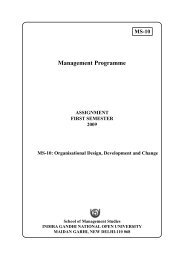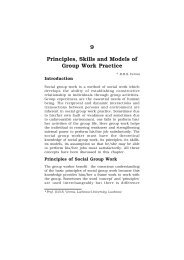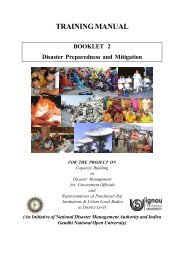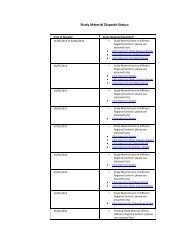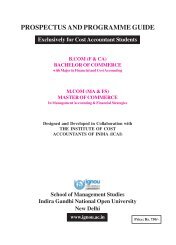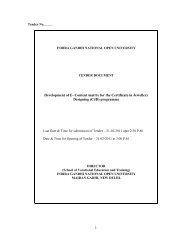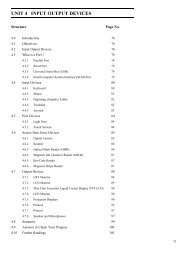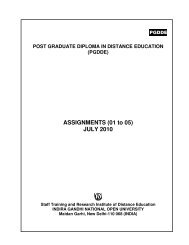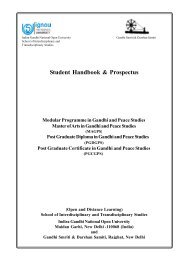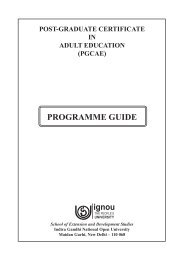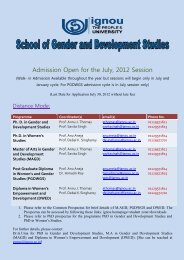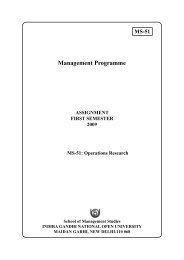PROSPECTUS AND PROGRAMME GUIDE - IGNOU
PROSPECTUS AND PROGRAMME GUIDE - IGNOU
PROSPECTUS AND PROGRAMME GUIDE - IGNOU
You also want an ePaper? Increase the reach of your titles
YUMPU automatically turns print PDFs into web optimized ePapers that Google loves.
Objective<br />
Course-10<br />
BCO-036: Company Accounts, Cost and Management Accounting<br />
(i)<br />
(ii)<br />
To provide working knowledge of accounting principles and procedures for companies in accordance with<br />
the statutory requirements.<br />
To acquaint the students with cost and management accounting techniques and practices.<br />
Part A: Company Accounts (50 Marks)<br />
1. Accounting standards - relevance and significance; national and international accounting standards.<br />
2. Accounting for share capital transactions - issue of shares at par, at premium and at discount; forfeiture<br />
and re-issue of shares; buy-back of shares; redemption of preference shares; rights issue.<br />
3. Issue of debentures - accounting treatment and procedures; redemption of debentures; conversion of<br />
debentures into shares.<br />
4. Underwriting of issues; acquisition of business; profits prior to incorporation; treatment of preliminary<br />
expenses.<br />
5. Preparation and presentation of final accounts of joint stock companies as per company law requirements;<br />
bonus shares.<br />
6. Holding and subsidiary companies - accounting treatment and disclosures; consolidation of accounts.<br />
7. Valuation of shares and intangible assets.<br />
Part B: Cost and Management Accounting (50 Marks)<br />
8. Cost accounting – objectives of costing system; cost concepts and cost classification; management<br />
accounting – nature and scope; role of management accountant, tools and techniques of management<br />
accounting; distinction between financial accounting, cost accounting and management accounting.<br />
9. Elements of cost:<br />
(i) Material cost – purchase procedures, store keeping and inventory control, fixing of minimum, maximum<br />
and re-order levels, ABC analysis, pricing of receipts and issue of material and accounting thereof;<br />
accounting and control of wastage, spoilage and defectives.<br />
(ii) Labour cost – classification of labour costs, payroll procedures, monetary and non-monetary incentive<br />
schemes; labour turnover and remedial measures; treatment of idle time and overtime.<br />
(iii) Direct expenses – nature, collection and classification of direct expenses and its treatment.<br />
(iv) Overheads – nature, classification, collection, allocation, apportionment, absorption and control of<br />
overheads.<br />
10. Methods of costing - unit costing, contract costing.<br />
11. Budgetary control – preparation of various types of budgets, advantages and limitations; budgetary control<br />
reports to management.<br />
12. Marginal costing - application of marginal costing; cost-volume-profit relationship; break-even analysis,<br />
preparation of break-even charts; profit – volume graph; practical application of profit volume ratio.<br />
13. Analysis and interpretation of financial statements - nature, objectives; latest trends in presenting financial<br />
data; importance and limitations; accounting ratios - classification, advantages and limitations.<br />
14. Cash flow statements – classification of cash flows, preparation and usefulness.<br />
A-31



